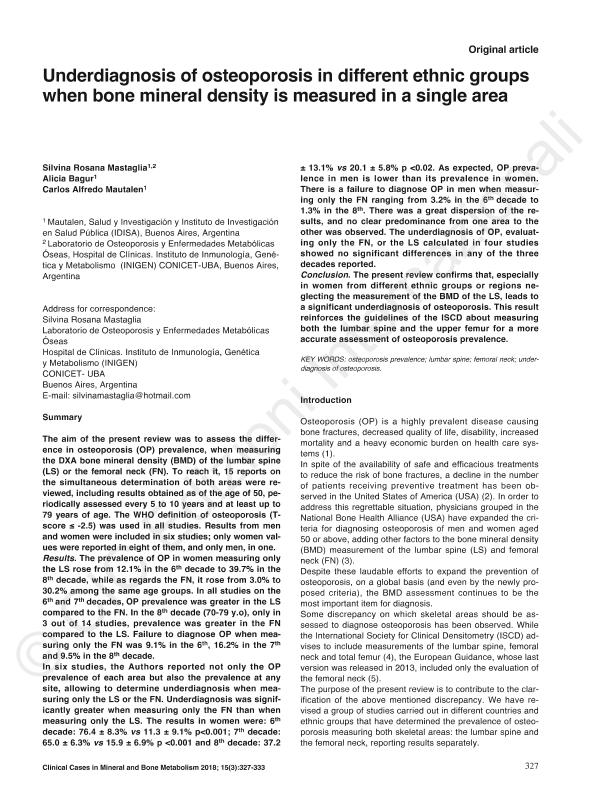Artículo
Underdiagnosis of osteoporosis in different ethnic groups when bone mineral density is measured in a single area
Fecha de publicación:
11/2018
Editorial:
Edizioni Minerva Medica
Revista:
Clinical Cases in Mineral and Bone Metabolims
ISSN:
1724-8914
Idioma:
Inglés
Tipo de recurso:
Artículo publicado
Clasificación temática:
Resumen
The aim of the present review was to assess the difference in osteoporosis (OP) prevalence, when measuring the DXA bone mineral density (BMD) of the lumbar spine (LS) or the femoral neck (FN). To reach it, 15 reports on the simultaneous determination of both areas were reviewed, including results obtained as of the age of 50, periodically assessed every 5 to 10 years and at least upto 79 years of age. The WHO definition of osteoporosis (T-score ≤ -2.5) was used in all studies. Results from men and women were included in six studies; onlywomen values were reported in eight of them, and only men, in one.Results. The prevalence of OP in women measuring only the LS rose from 12.1% in the 6th decade to 39.7% in the 8th decade, while as regards the FN, it rose from 3.0% to 30.2% among the same age groups. In all studies on the 6th and 7th decades, OP prevalence was greater in the LS compared to the FN. In the 8th decade (70-79 y.o), only in 3 out of 14 studies, prevalence was greater in the FN compared to the LS. Failure to diagnose OP when measuring only the FN was 9.1% in the 6th, 16.2% in the 7th and 9.5% in the 8th decade. In six studies, the authors reported not only the OP prevalence of each area but also the prevalence at any site, allowing to determine underdiagnosis when measuring only the LS or the FN. Underdiagnosis was significantly greater when measuring only the FN than when measuring only the LS. The results in women were: 6thdecade: 76.4 ± 8.3% vs 11.3 ± 9.1% p<0.001; 7th decade: 65.0 ± 6.3% vs 15.9 ± 6.9% p <0.001 and 8th decade: 37.2± 13.1% vs 20.1 ± 5.8% p <0.02. As expected, OP prevalence in men is lower than its prevalence in women. There is a failure to diagnose OP in men when measuring only the FN ranging from 3.2% in the 6th decade to 1.3% in the 8th. There was a great dispersion of the results, and no clear predominance from one area to the other was observed. The underdiagnosis of OP, evaluating only the FN, or the LS calculated in four studiesshowed no significant differences in any of the three decades reported.Conclusion. The present review confirms that, especially in women from different ethnic groups or regions neglecting the measurement of the BMD of the LS, leads to a significant underdiagnosis of osteoporosis. This result reinforces the guidelines of the ISCD about measuring both the lumbar spine and the upper femur for a more accurate assessment of osteoporosis prevalence
Palabras clave:
OSTEOPOROSIS
,
DIAGNOSTICO
,
DENSITOMETRIA
Archivos asociados
Licencia
Identificadores
Colecciones
Articulos(INIGEM)
Articulos de INSTITUTO DE INMUNOLOGIA, GENETICA Y METABOLISMO
Articulos de INSTITUTO DE INMUNOLOGIA, GENETICA Y METABOLISMO
Citación
Mastaglia, Silvina Rosana; Bagur, Alicia Cristina; Mautalen, Carlos Alfredo; Underdiagnosis of osteoporosis in different ethnic groups when bone mineral density is measured in a single area; Edizioni Minerva Medica; Clinical Cases in Mineral and Bone Metabolims; XV; 3; 11-2018; 327-333
Compartir




